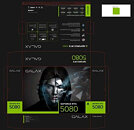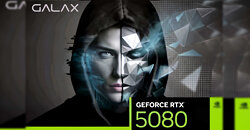- Joined
- Oct 9, 2007
- Messages
- 47,849 (7.39/day)
- Location
- Dublin, Ireland
| System Name | RBMK-1000 |
|---|---|
| Processor | AMD Ryzen 7 5700G |
| Motherboard | Gigabyte B550 AORUS Elite V2 |
| Cooling | DeepCool Gammax L240 V2 |
| Memory | 2x 16GB DDR4-3200 |
| Video Card(s) | Galax RTX 4070 Ti EX |
| Storage | Samsung 990 1TB |
| Display(s) | BenQ 1440p 60 Hz 27-inch |
| Case | Corsair Carbide 100R |
| Audio Device(s) | ASUS SupremeFX S1220A |
| Power Supply | Cooler Master MWE Gold 650W |
| Mouse | ASUS ROG Strix Impact |
| Keyboard | Gamdias Hermes E2 |
| Software | Windows 11 Pro |
The box-art of upcoming GALAX GeForce RTX 5080 "Blackwell" graphics card has much to say about the graphics architecture, without dropping any explicit mentions. The front-face of the box features a hooded human face—nothing fancy, until you begin to pay attention to the details. Half the face is composed of triangles streaming toward the face, while the other half is composed in place by a blue stream of light, as if to denote that it's being drawn by a fundamentally different method than "triangles."
The triangles here represent classic raster 3D graphics, while the other spirit-like half denotes neural rendering. Here's where it gets interesting. Both kinds of rendering are being applied to the same frame, and so neural rendering is fundamentally different from DLSS 3 Frame Generation, a technology that draws alternate frames using optical flow, motion vectors, and AI. Neural rendering appears to be, at least from this GALAX box-art, a technology that runs in real-time, where some elements, portions, or details of a frame are rendered by a generative AI, and others by raster 3D graphics.


View at TechPowerUp Main Site | Source
The triangles here represent classic raster 3D graphics, while the other spirit-like half denotes neural rendering. Here's where it gets interesting. Both kinds of rendering are being applied to the same frame, and so neural rendering is fundamentally different from DLSS 3 Frame Generation, a technology that draws alternate frames using optical flow, motion vectors, and AI. Neural rendering appears to be, at least from this GALAX box-art, a technology that runs in real-time, where some elements, portions, or details of a frame are rendered by a generative AI, and others by raster 3D graphics.


View at TechPowerUp Main Site | Source



